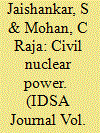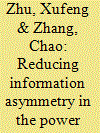| Srl | Item |
| 1 |
ID:
184703


|
|
|
| 2 |
ID:
179719


|
|
|
|
|
| Summary/Abstract |
This paper explores the differences in technological priorities for decarbonization of the Russian and the European power sectors up to 2040 and investigates the main drivers of such differences. We used updated cost and performance data to conduct a comparative analysis of technologies based on levelized cost of electricity. Calculation of carbon avoided costs allowed us to found the pool of cost-efficient low-carbon technologies for the Russian power industry as well as the level of carbon prices needed to support their development. Also, we have explained the reasons which cause differences in decarbonization priorities in Russia and Europe. We have also investigated the impact of system requirements (and associated costs) in terms of capacity availability and its operating modes on the competitiveness of renewable energy sources and conventional power plants. Consideration of these requirements and costs improves the quality of power system planning and policy-making processes under the strict limits on greenhouse gas emissions. Based on performed analysis we suggest economically reasonable decarbonization strategy of the Russian power industry as well as the necessary level of carbon prices/taxes for various low- and non-carbon technologies to support their development.
|
|
|
|
|
|
|
|
|
|
|
|
|
|
|
|
| 3 |
ID:
121344


|
|
|
|
|
| Publication |
2013.
|
| Summary/Abstract |
More than 40% of China's total CO2 emissions originate from the power industry. The realization of energy saving and emission reduction within China's power industry is therefore crucial in order to achieve CO2 emissions reduction in this country. This paper applies the autoregressive-distributed lag (ARDL) co-integration model to study the major factors which have influenced CO2 emissions within China's power industry from 1980 to 2010. Results have shown that CO2 emissions from China's power industry have been increasing rapidly. From 1980 to 2010, the average annual growth rate was 8.5%, and the average growth rate since 2002 has amounted to 10.5%. Secondly, the equipment utilization hour (as an indicator of the power demand) has the greatest influence on CO2 emissions within China's power industry. In addition, the impact of the industrial added value of the power sector on CO2 emissions is also positive from a short-term perspective. Thirdly, the Granger causality results imply that one of the important motivators behind China's technological progress, within the power industry, originates from the pressures created by a desire for CO2 emissions reduction. Finally, this paper provides policy recommendations for energy saving and emission reduction for China's power industry.
|
|
|
|
|
|
|
|
|
|
|
|
|
|
|
|
| 4 |
ID:
169720


|
|
|
|
|
| Summary/Abstract |
The regulated price mechanism in China's power industry has attracted much criticism because of its incapability to optimize the allocation of resources. To build an “open, orderly, competitive and complete” power market system, the Chinese government launched an unprecedented marketization reform in 2015 to deregulate the electricity price. This paper examines the impact of electricity price deregulation at the industry level. We first construct two-stage dynamic game models to portrait the interaction between the coal and coal-fired power industries. Using the models, we compare analytically the equilibriums with and without electricity price regulation concerning electricity price, electricity generation, coal price and coal production. The theoretical analyses find three regulated electricity price intervals that differentiate the reform impacts. Afterward, we collect empirical data to estimate the model parameters. The influences on the two industries in terms of market outcome and industrial profitability are simulated. Our results suggest that the current regulated electricity price falls within the medium interval, which means deregulation will result in higher electricity price but lower coal price, less coal production and less electricity generation. The robustness analyses show that our results hold with respect to the electricity generation efficiency and price sensitivity of electricity demand.
|
|
|
|
|
|
|
|
|
|
|
|
|
|
|
|
| 5 |
ID:
136191


|
|
|
|
|
| Summary/Abstract |
We examine the challenges and opportunities to introduce emissions trading (ETS) in China’s electricity sector, in which the interaction between ETS and electricity market reform plays a major role. China’s electricity sector is currently in a slow progress towards a more competitive and market-based system. Both equal share dispatching policy and regulated wholesale and retail pricing policies pose significant challenges for implementation of ETS in China’s electricity sector. One of the important points of ETS is to give a price for carbon emissions and establish a cost pass-through mechanism (reminded that the essential of carbon pricing is to put a price on carbon emissions that is equal to discounted value of the external damages). It should be regarded as a part of broader policy package for energy and resources price reform. This will require that any low-carbon power policy should be considered as a part of whole policy package aiming at further liberalizing the electricity sector in China. Three policy options are identified to incorporate ETS with electricity reform under different circumstances. A combination of those three options is also proposed to break the lock and reinforce the positive interaction between ETS and the transition towards a competitive electricity system, in link with current pilot ETS designs. A roadmap to introduce ETS in a stepwise manner is suggested.
|
|
|
|
|
|
|
|
|
|
|
|
|
|
|
|
| 6 |
ID:
051500


|
|
|
| 7 |
ID:
133080


|
|
|
|
|
| Publication |
2014.
|
| Summary/Abstract |
Measuring variations in efficiency and its extension, eco-efficiency, during a restructuring period in different industries has always been a point of interest for regulators and policy makers. This paper assesses the impacts of restructuring of procurement in the Iranian power industry on the performance of power plants. We introduce a new slacks-based model for Malmquist-Luenberger (ML) Index measurement and apply it to the power plants to calculate the efficiency, eco-efficiency, and technological changes over the 8-year period (2003-2010) of restructuring in the power industry. The results reveal that although the restructuring had different effects on the individual power plants, the overall growth in the eco-efficiency of the sector was mainly due to advances in pure technology. We also assess the correlation between efficiency and eco-efficiency of the power plants, which indicates a close relationship between these two steps, thus lending support to the incorporation of environmental factors in efficiency analysis.
|
|
|
|
|
|
|
|
|
|
|
|
|
|
|
|
| 8 |
ID:
113482


|
|
|
|
|
| Publication |
2012.
|
| Summary/Abstract |
This paper focuses on the institutional framework for sulfur dioxide emission information disclosure (SDEID) in power industries. The authors argue that mandatory and voluntary SDEID are two complementary regulatory instruments for emission reduction in the power industry. An analytical framework of SDEID with six facets is suggested in this paper to demonstrate relevant legal provisions and regulatory policies of mandatory and voluntary SDEID of power industries in the US. Empirical research shows that mandatory and voluntary SDEID of the power industry have been regulated simultaneously in the US. The foundation of power companies' willingness to disclose emission information voluntarily is the combination of mandatory scientific monitoring with market regulation in the current SDEID system in the US. In comparison, the SDEID of power industries has yet to be widely implemented in developing countries. Finally, the paper provides some implications to developing countries that plan to learn institutional arrangements from developed countries.
|
|
|
|
|
|
|
|
|
|
|
|
|
|
|
|
| 9 |
ID:
116139


|
|
|